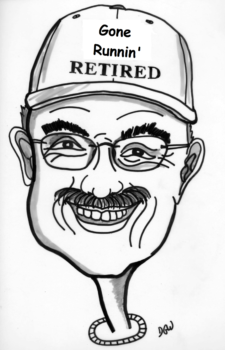Recently, I’ve had some muscle strains that have prevented me from running for more than 6 to 10 minutes without walking to reduce the chance of prolonging the issue. During one of my long runs, thinking about my July 4th race finish, my best finish time since 2011, I pondered, “I’ll never be able to run a race like that again.” Then again, I should never say never and thought of 7 things you should never do.
1. Never Run with Your Back to Traffic
I prefer to run on asphalt. There are fewer tripping hazards, and asphalt is softer than cement. Running on asphalt means running on roads, and on most roads in our area, you need to run in the same lane as traffic.
I try looking into a driver’s eyes. The only way to do this is to run facing traffic. Over time, you will become aware of the change in drivers’ eyes and facial expressions as they are about to step on the gas.
Remember that drivers making a right turn onto the road you are running on will be looking to their left and never see you on their right.
By running facing traffic, you’ll be able to jump in the ditch to your left before a vehicle hits you.
2. Never Challenge “Worse”
No matter the circumstance, it can always get worse. Rain can be heavier, wind can be more brutal, snow can be deeper, and the dew point can get higher.
So, after you run this winter in 18 inches of snow, rather than saying “it can’t get worse,” say, “I don’t believe people were trying to drive in this weather.”
3. Never Put Off to Tomorrow What You Can do Today
The weather may be bad today, and it can worse tomorrow. The 2009 Blue and Gray half-marathon forecast was 33 degrees with either rain, snow, or freezing rain. On race morning, the roads did not have ice on them, and the temperature was 34 degrees.
While contingency planning days before the race, I had asked FPD if I could start the race later than 7:30 am. They answered, “no.” I then asked if I could postpone the race to the following week. They answered, “yes.”
With the roads runnable, I started the race as scheduled in freezing 34-degree rain. The following week, there were 18 inches of snow on the streets.
Life is short. Things you are physically able to do today, you may not be able to do when you are older. If you have a savings plan for retirement, also have a spending plan to enjoy today.
4. Never Argue with a Customer
An adage, “you can never win an argument with a customer.” If you do win, you will lose them as a customer.
You may think some of your customers are morons and call them morons behind their backs. I know I’ve had a few.
Develop your customers’ procedures to satisfy their needs, are intuitive, and be quickly followed.
When they don’t follow what you want them to do, adapt rather than argue. Would you mind giving in to your customer’s position as you are more wrong?
5. Never Fight City Hall
Another adage, “you can’t beat City Hall.”
They have taxing powers, permitting powers, and police powers. They make the laws to their benefit.
If the sign says, “Sidewalk Closed,” cross to the other side of the street. They may miss you this time. But, you never know.
In the past, I’ve made suggestions to race directors. Their typical response is, “we’ll do whatever they allow us to do.”
I’ve learned over time that permitting officials want you to give them a plan to approve rather than giving you options. Be agile with your plan to adapt to their objections.
Make sure that you follow through to match your plan. It’s nice to say, “we’re doing the same thing as last year.”
6. Never Assume
Communicate rather than assume.
In the past, I wrote concise timing agreements with races. They were precise about the tasks we were doing.
However, 10 minutes before the scheduled start of one race, I asked the race director, “are all your course marshals in place?” Her response was, “I assumed you were doing that.” In later years, we didn’t time that race, and I added the course marshal question to my planning meeting agenda.
Even with a more extended planning meeting agenda, I assumed the race director was listening and understanding. It was a flawed assumption.
7. Never Stop Moving Forward
Relentless forward progress is my mantra while competing in ultras.
If you never stop moving forward, you will eventually get to the finish line.
If you can’t run and drink or run and eat, walk. If an ultra has ten aid stations and you spend 2 minutes sitting at each aid station, you add 20 minutes to your finish time.
If you are no longer able to run, walk. Don’t stop. Don’t quit. If you get into the next aid station after the cutoff, make them pull you out of the race. If you still are ahead of the cutoff, keep moving forward.
Quitting will hurt more in the long run than the pain you are having while trying to run.
You can do it. Keep moving.
